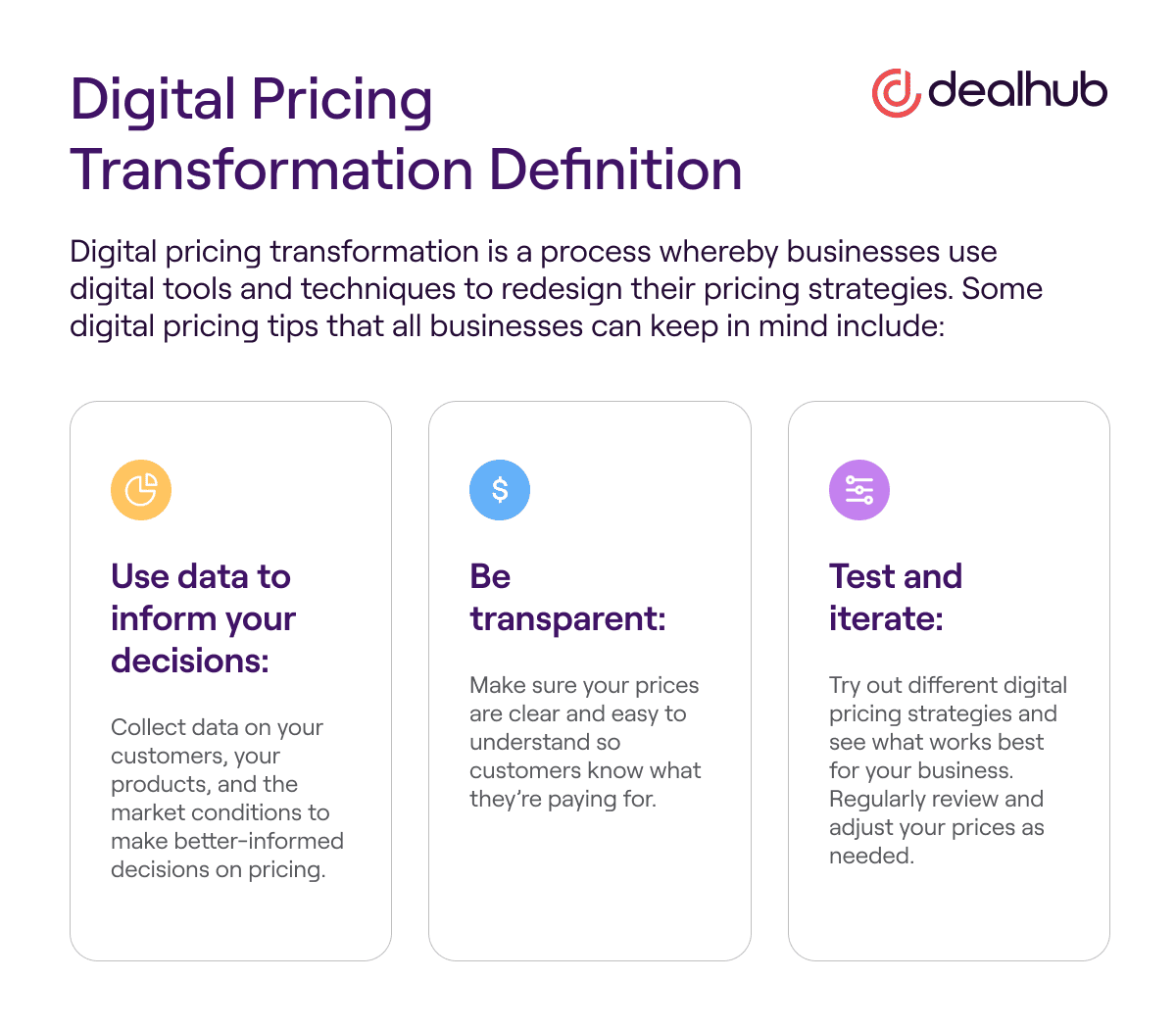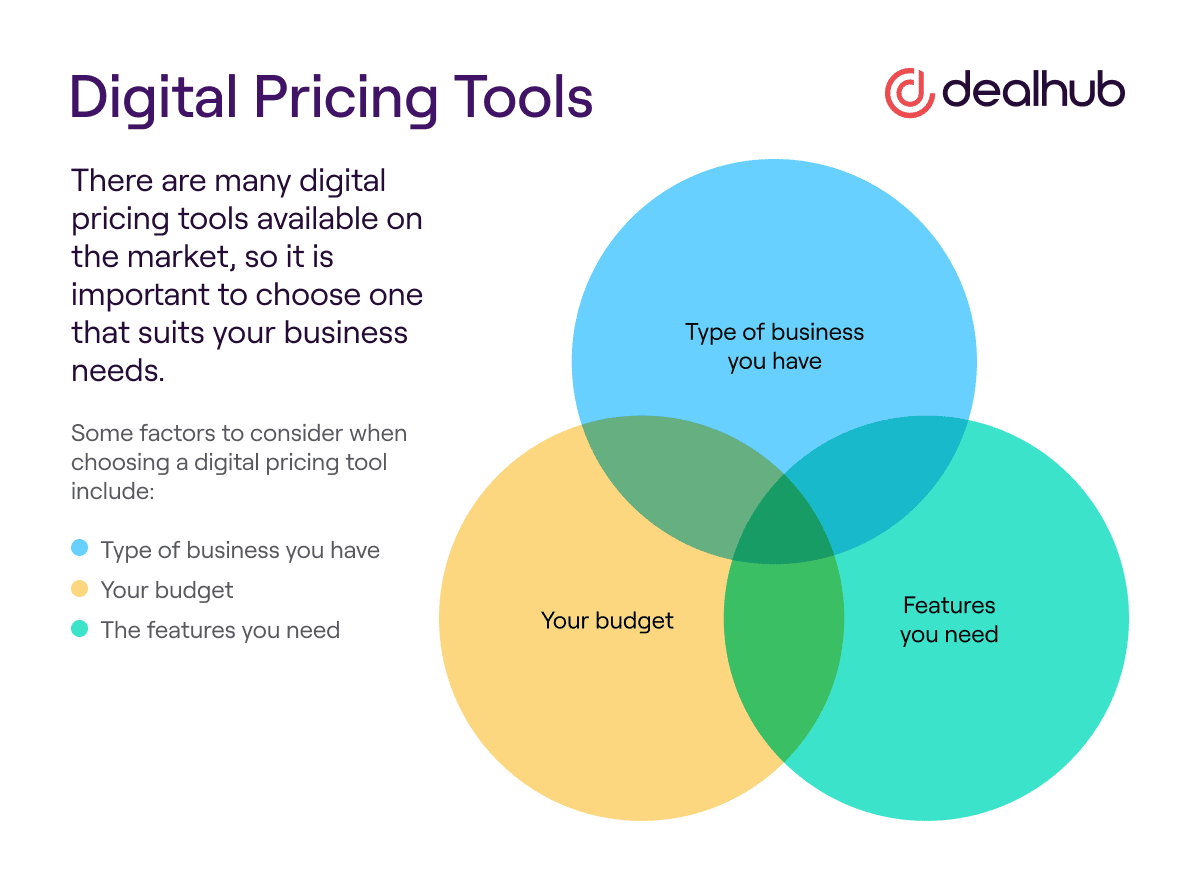Digital Pricing
Table of Contents
What is Digital Pricing?
Digital pricing is the process of setting prices for products and services using digital tools and techniques. This can involve anything from using algorithms to automatically set prices based on market conditions to manually setting prices for specific products or services.
Digital Pricing Transformation Definition
Digital pricing transformation is a process whereby businesses use digital tools and techniques to redesign their pricing strategies. This can involve anything from developing new pricing models to implementing automated pricing systems. The goal of digital pricing transformation is to improve business performance by making pricing more efficient and effective.
Digitizing pricing can offer numerous benefits, including improved accuracy, transparency, and speed. Additionally, digital tools can help businesses to better understand customer needs and behaviors and can allow for more personalized pricing.
Companies should consider digital pricing, which can transform their pricing strategy based on their specific goals and needs. However, some digital pricing tips that all businesses can keep in mind include:
- Use data to inform your decisions: Collect data on your customers, your products, and the market conditions to make better-informed decisions on pricing.
- Be transparent: Make sure your prices are clear and easy to understand so customers know what they’re paying for.
- Test and iterate: Try out different digital pricing strategies and see what works best for your business. Regularly review and adjust your prices as needed.

How Digital Transformation is Changing the Pricing Process
Digital transformation is changing the way businesses price their products and services. In the past, businesses would rely on manual processes to determine prices. However, with digital technology, businesses can now automate pricing using data analytics and pricing models built into sales tools like CRM and configure price quote software (CPQ). This allows businesses to be more strategic about pricing and to better understand the impact of pricing on their bottom line.
Digitalizing Existing Pricing Processes
Today, digital technology is rapidly changing the way businesses operate, and pricing processes are no exception. Many companies are turning to digital solutions to streamline their pricing processes and improve efficiency.
Digital pricing solutions offer a number of advantages over traditional methods. They can help reduce costs, speed up decision-making, and improve accuracy. In addition, digital solutions offer greater flexibility and transparency, which can help build trust with customers.
Choosing the right digital pricing solution for your business requires understanding your needs and objectives. Here are a few factors to consider:
- Cost: How much are you willing to spend on a digital pricing solution?
- Ease of use: How easy is the solution to use and implement?
- Features: What features are important to you and your business?
- Flexibility: How flexible does the solution need to be to accommodate your changing needs?
- Support: What level of support does the vendor offer?
Digital Pricing Models
There are various digital pricing models that businesses can choose from, each with its own advantages and disadvantages.
The most common digital pricing models are tiered, pay-per-use, subscription, and freemium:
- Tiered pricing is common in SaaS businesses. Different features are offered at different prices, depending on the level of service desired. Additional features are unlocked as the user pays more.
- Pay-per-use digital pricing is where customers are charged for each digital product or service they use.
- Subscription digital pricing is where customers pay a monthly or annual fee to access a digital product or service.
- Freemium digital pricing is where customers can access a digital product or service for free but are charged for additional features or content.
Each digital pricing model has its own benefits and drawbacks that businesses need to consider when choosing how to price their digital products and services. Tiered pricing allows users to try out the basic level of a product before committing to paying for more expensive features, and also allows companies to upsell users on higher levels of service.
Pay-per-use digital pricing is often seen as the most straightforward and easy-to-understand digital pricing model. However, it can be expensive for customers who use a lot of digital products or services, and it can be difficult to upsell customers on additional features or content.
Subscription pricing is a good option for businesses that offer digital products or services that customers will use regularly. It can be more affordable for customers than pay-per-use digital pricing, and it gives businesses a consistent revenue stream. However, subscription pricing can be difficult to scale, and it can be hard to convince customers to sign up for a subscription if they only want to use a digital product or service occasionally.
Freemium digital pricing is a good way to attract new customers and get them interested in a digital product or service. However, it can be difficult to generate revenue from freemium digital products or services, and businesses need to be careful not to give away too much for free.
Digital pricing is a complex topic, and there is no one-size-fits-all digital pricing model. Businesses need to carefully consider their individual needs and objectives when choosing a digital pricing model. The most important thing is to choose a digital pricing model that will allow the business to generate revenue and profit from its digital products and services.
Digital Pricing Trend: Dynamic Pricing
Dynamic prices are those that change based on customer demand. In other words, the price of a digital product or service is not static but rather fluctuates according to how much customers are willing to pay for it. This type of pricing is also sometimes referred to as “surge” or “demand-based” pricing.
Dynamic pricing is becoming increasingly common as businesses strive to optimize their revenue. In many cases, it can be a more effective way to price products and services than traditional methods, such as fixed pricing. That’s because dynamic prices are more responsive to changes in demand, meaning that businesses can generate more revenue when demand is high and vice versa.
Of course, dynamic pricing is not without its challenges. Perhaps the biggest challenge is setting prices that strike the right balance between maximizing revenue and meeting customer needs. After all, if prices are too high, customers may be discouraged from purchasing, while if prices are too low, businesses may miss out on potential profits. Finding the perfect price point can be difficult, but it’s essential for businesses that want to succeed with digital pricing.
Overall, dynamic pricing is a pricing strategy that can be beneficial for both businesses and customers. By changing prices in response to demand, businesses can optimize their revenue, while customers can enjoy more affordable prices when demand is low. Although digital pricing can be challenging, it can be a great way to optimize your business’s bottom line.
Better Margins from Digital Pricing Transformation
Digital pricing is the process of setting prices for goods and services using digital technologies. This can be done manually or automatically, but the main aim is to use data and analytics to price more accurately and efficiently.
The benefits of digital pricing are vast, but perhaps most importantly, it can help businesses achieve better margins. With accurate pricing, businesses can make sure they are not overcharging or undercharging for their products and services. This can lead to increased profits, which can be reinvested into the business or used to lower prices and attract more customers.
Digital pricing transformation is not always easy, but the rewards can be great. If you are considering making the switch to digital pricing, make sure you have a clear strategy in place. Work with a pricing expert to ensure you are making the most of your data so you can achieve better margins for your business.

Redesigning the B2B Pricing Process
The process of pricing in a business-to-business (B2B) context is ripe for transformation. In an increasingly digital world, the traditional methods of pricing products and services are no longer effective. Businesses must adopt a new approach to pricing that takes into account the latest changes in technology and consumer behavior.
There are several key aspects of a successful pricing transformation in B2B businesses. First, Sales Operations must move away from manual pricing processes and instead adopt automated pricing tools. This will allow them to respond more quickly to changes in the market and make more accurate pricing decisions. Second, businesses must create flexible pricing models that can be easily adapted to different customer needs. And finally, businesses need to focus on creating a seamless customer experience by integrating pricing into the overall customer journey. By redesigning the B2B pricing process, businesses can stay ahead of the curve and better meet the needs of their customers.
Digital Pricing Strategy
Digital pricing is a complex and ever-changing field. Businesses must be strategic in their approach to digital pricing, taking into account customer behavior, developing new pricing models, and using data to inform their decisions. By doing so, businesses can ensure that they are maximizing revenue and profits from digital products and services.
Digital pricing is complex because digital products and services are often priced differently than traditional products and services. This is due to the fact that digital goods and services can be delivered instantly and often have no marginal cost of production. As a result, businesses must be strategic in their approach to digital pricing.
Customer behavior is a key consideration in digital pricing strategy. Businesses must understand how customers interact with digital products and services in order to price them effectively.
Data is another important consideration in digital pricing. Businesses must use data to understand customer behavior and develop new pricing models. Data can also be used to monitor the effectiveness of digital pricing strategies. By understanding how customers respond to prices, businesses can make necessary adjustments to their strategies.
Digital pricing is a complex and ever-changing field. Businesses must be strategic in their approach to digital pricing, taking into account customer behavior, developing new pricing models, and using data to inform their decisions. By doing so, businesses can ensure that they are maximizing revenue and profits from digital products and services.
Digital Pricing Tools
There are a variety of pricing tools available on the market, ranging from simple calculators to complex optimization algorithms that automate product configuration and pricing. Many pricing tools are designed for specific industries, such as retail or manufacturing. Others are more general-purpose and can be used in any type of business.
Pricing tools can be an essential part of a company’s overall pricing strategy. By helping businesses set prices that are competitive and profitable, pricing tools can help companies grow and succeed. There are many digital pricing tools available on the market, so it is important to choose one that suits your business needs.
Some factors to consider when choosing a digital pricing tool include:
- The type of business you have
- Your budget
- The features you need
Implementing a digital pricing tool can help you automate a crucial part of the sales process and ensure that prices are set accurately and efficiently, giving you a competitive edge and optimizing revenue.

CPQ
If you sell digital products, then you know how important it is to have a robust CPQ (configure-price-quote) solution in place. With CPQ, you can easily configure your products and pricing based on customer needs and preferences. This results in more accurate quotes and fewer pricing errors.
CPQ also provides powerful features for discounts and promotions. You can easily configure different discount tiers based on customer volume or other criteria. This makes it easy to offer bulk discounts or targeted promotions. CPQ is an essential tool for any digital business. It streamlines the pricing process and helps ensure accuracy and fairness. Using CPQ software, you can offer your customers the best possible prices for your products.
Deal Room
A deal room brings B2B customers and vendors together in one digital sales room and integrates all the necessary technology, documentation, and data required to close deals.
Each deal room is customized for each buyer based on just a few inputs confirmed during their first sales call. It creates a deeper connection between buyers and sellers. The digital sales room allows all stakeholders to communicate with each other in real-time, eliminating fragmented and repetitive communication throughout the sales process.
A deal room provides live notifications about buyer engagement, so sales teams can identify relevant stakeholders, gauge buyer interest, know exactly when to contact them, and seek internal guidance if certain flags are raised.
Salespeople are used to going back and forth through emails, sending relevant documents only once a potential customer is ready for them. A deal room accelerates deals by incorporating relevant contract materials, accurate quotes, and ESignature into one digital location, generated through a series of questions asked at the beginning of the sales process.
The entire buying committee, sales team, and marketing team have access to the deal room, ensuring buyers and sellers know exactly what they’re doing at any given time. A deal room removes the friction in the sales process so that your sales team can send accurate and personalized proposals to prospective clients before your competitors can – leading to increased win rates and sales velocity.
Synonyms
- digital pricing strategy
- digital pricing model
- configure-price-quote
People Also Ask
What is a digital pricing model?
A digital pricing model is a tool used by businesses to price their products or services. It takes into account the cost of goods or services, the demand for them, and the competition in the market. The goal of a digital pricing model is to help businesses maximize their profits while still providing a fair price to consumers.
What are the 5 levels of strategic pricing?
The 5 levels of strategic pricing are:
1. Cost-based pricing: This is where you set your prices based on the cost of producing your product or service.
2. Competition-based pricing: This is where you set your prices based on what your competitors are charging for similar products or services.
3. Customer-based pricing: This is where you set your prices based on what your customers are willing to pay for your product or service.
4. Value-based pricing: This is where you set your prices based on the perceived value of your product or service.
5. Profit-based pricing: This is where you set your prices based on how much profit you want to make.
You can use any combination of these 5 levels of strategic pricing to come up with a price for your product or service. What’s important is that you are clear about why you are charging what you are charging and that your price is in line with the value that your product or service provides.
What are the steps in the pricing process?
There are four steps in the pricing process:
1. Cost determination
2. Price setting
3. Pricing strategy
4. Price implementation
Cost determination is the first step and involves figuring out the costs associated with producing a product or delivering a service. This includes things like the cost of materials, labor, and overhead. Once the costs are known, a price can be set.
Price setting is the second step and involves deciding on a price that will cover the costs while also making a profit. Pricing strategy is the third step and involves choosing a pricing method (e.g., competitive pricing, value-based pricing, etc.) and deciding on any discounts or promotions.
Price implementation is the fourth and final step in the process and involves putting the price into effect. This might involve setting up a pricing structure, implementing discounts or promotions, and so on.
What are pricing tools?
Pricing tools are software applications that help businesses set prices for their products or services.
Pricing tools are an essential part of the revenue stack as they are used to determine price points for new products or services or to optimize existing pricing structures. Pricing tools typically consider factors such as competitor pricing, cost of goods sold, and customer demand in order to generate optimal prices.






